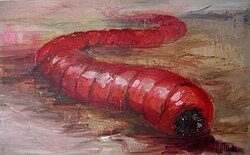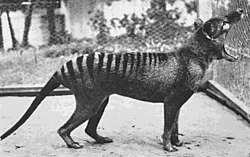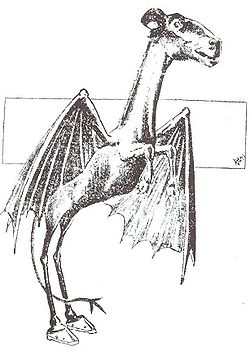List
Aquatic or semi-aquatic
| Name | Other names | Description | Purported location | Depiction |
|---|---|---|---|---|
| Anguila peluda [10] | Hairy Eel | Pond animal | Pamital ravine, Canary Islands | |
| Bunyip [11] | Bahnyip | Amphibious creature | Australia |  |
| Cadborosaurus [12] | Caddy | Sea animal | Pacific Coast of North America |  |
| Champ [13] | Champy | Lake monster | Lake Champlain, North America |  |
| Cryptid Whales [14] [15] | Giglioli's Whale, Rhinoceros dolphin, High-finned sperm whale, Alula whale, Unidentified beaked whales | Sea animal | Pacific Ocean, Atlantic Ocean, Indian Ocean |  |
| Dobhar-chú [16] | Water Hound, King Otter | Extra-large otter-like carnivorous aquatic mammal | Ireland |  |
| Gloucester sea serpent [17] | Large serpent | Gloucester, Cape Ann |  | |
| Great auk (surviving populations) [18] | Pinguinus impennis, garefowl | Aquatic flightless bird | Northern Atlantic |  |
| Iemisch [19] | Iemisch Listai | Mix of a jaguar and otter | Patagonia | |
| Igopogo [20] | Kempenfelt Kelly | Lake monster | Lake Simcoe, Ontario (Canada) | |
| Labynkyr Devil [21] [22] [23] | Labynkyrsky Chert[ citation needed ] | Lake monster | Oymyakonsky Ulus, Sakha Republic, Russia | |
| Loch Ness Monster [24] | Nessie | Lake monster | Loch Ness, Scotland |  |
| Loveland Frog [25] | Loveland frogman, Loveland lizard | Humanoid frog | Loveland, Ohio |  |
| Manipogo [26] | Winnipogo | Lake monster | Lake Manitoba, Canada | |
| Megalodon (surviving populations) [27] [28] [29] | Otodus megalodon [a] | Giant prehistoric shark | Oceans | |
| Mokele-mbembe [30] | Dinosaur (lake, river and/or swamp monster) | Republic of the Congo |  | |
| Montauk Monster | Small bald beaked mammal | Montauk, Long Island, NY | ||
| Morgawr [31] | Sea serpent | Falmouth Bay | ||
| Ogopogo [13] | N'ha•a•itk, Naitaka | Lake monster | Lake Okanagan, Canada |  |
| Oklahoma Octopus [32] | giant octopus | Lake Thunderbird, Oklahoma, USA | ||
| Sea serpents [33] | Sea animals, dinosaurs | All bodies of water |  | |
| Selma [34] | Seljordsormen | Lake monster | Lake Seljord, Telemark, Norway | |
| Steller's sea ape [35] | Sea animal | Pacific Ocean |
Terrestrial
| Name | Other names | Description | Purported location | Depiction |
|---|---|---|---|---|
| British big cats [36] | Alien big cats (ABCs), phantom cats, mystery cats, English lions, Beast of Bodmin, Beast of Exmoor | Carnivorous mammal | Great Britain |  |
| Chupacabra [37] | Chupacabras (Spanish for goat-sucker) | Puerto Rico (originally), South and Central America, Southern North America |  | |
| Dover Demon [38] | Dover, Massachusetts |  | ||
| Fresno nightcrawler [39] | Long white legs with no torso | Fresno, California | ||
| Lizard Man of Scape Ore Swamp [40] | Lizard Man of Lee County | Bipedal | South Carolina, United States | |
| Mapinguari [41] | Mapinguary | Giant Ground Sloth or primate | Amazons |  |
| Michigan Dogman [42] | Humanoid dog | Wexford County, Michigan | ||
| Moa (surviving original populations) [43] [b] | Dinornis robustus (South Island giant moa), Dinornis novaezelandiae (North Island giant moa), Anomalopteryx didiformis (Bush moa, little bush moa, or lesser moa) | Medium to large flightless birds | New Zealand |  |
| Mongolian death worm [44] | Allghoi (or orghoi) khorkhoi | Worm-like animal | Gobi Desert (Asia) |  |
| Nandi bear [45] | Chemosit, Kerit, Koddoelo, Ngoelo, Ngoloko, Duba | Large carnivore | Eastern Africa |  |
| Not-deer [46] | Not deer | White-tailed deer with unnatural characteristics | Appalachia |  |
| Queensland Tiger [47] | Yarri | Large feline | Queensland | |
| Thylacine (surviving original populations) [48] [49] [c] | Tasmanian tiger. Tasmanian wolf, Thylacinus cynocephalus | Carnivorous marsupial | Australia |  |
Hominid
| Name | Other names | Description | Purported location | Depiction |
|---|---|---|---|---|
| Almas [13] | Abnauayu, almasty, albasty, bekk-bok, biabin-guli, golub-yavan, gul-biavan, auli-avan, kaptar, kra-dhun, ksy-giik, ksy-gyik, ochokochi, mirygdy, mulen, voita, wind-man, Zana | Non-human ape or hominid | Asia/Caucasus | |
| Amomongo [50] | Orang Mawas, Impakta | Ape or hominid | Negros Occidental, Philippines | |
| Bigfoot [51] | Sasquatch | Large and hairy ape-like creature | United States and Canada |  |
| Bukit Timah Monkey Man [52] | BTM, BTMM | Forest-dwelling hominid or other primate | Singapore | |
| Chatawa Monster [53] [54] | Large ape-like creature | Mississippi, United States | ||
| Chuchunya [55] | Large hominid | Russia | ||
| Fouke Monster [56] [57] | Jonesville Monster, Southern Sasquatch, Boggy Creek Monster | Hominid or other primate | Arkansas, United States | |
| Honey Island Swamp monster [58] | Letiche, Tainted Keitre | Hominid or other primate | Louisiana, United States | |
| Orang Pendek | Small hominid | Sumatra |  | |
| Nittaewo [59] | Nittevo | Small hominids | Sri Lanka | |
| Skunk ape [60] | Stink Ape, Myakka Ape, Myakka Skunk Ape | Primate | Florida, United States |  |
| Yeren [61] [60] | Yiren, Yeh Ren, Chinese Wildman | Primate (possible hominin) | China | |
| Yeti [62] | Abominable Snowman | Large and hairy human-like entity, various other descriptions | Himalayas (Asia) |  |
| Yowie [59] | Large and hairy human-like entity, various other descriptions | Australia |  |
Flying
| Name | Other names | Description | Purported location | Depiction |
|---|---|---|---|---|
| Jersey Devil [24] | Leeds Devil | Winged bipedal horse | United States, mainly the South Jersey Pine Barrens, as well as other parts of New Jersey and southeastern Pennsylvania |  |
| Mothman [63] | Winged Man, Bird Man, UFO-Bird, Mason Bird Monster | Winged bipedal | Mason County, West Virginia, United States |  |

